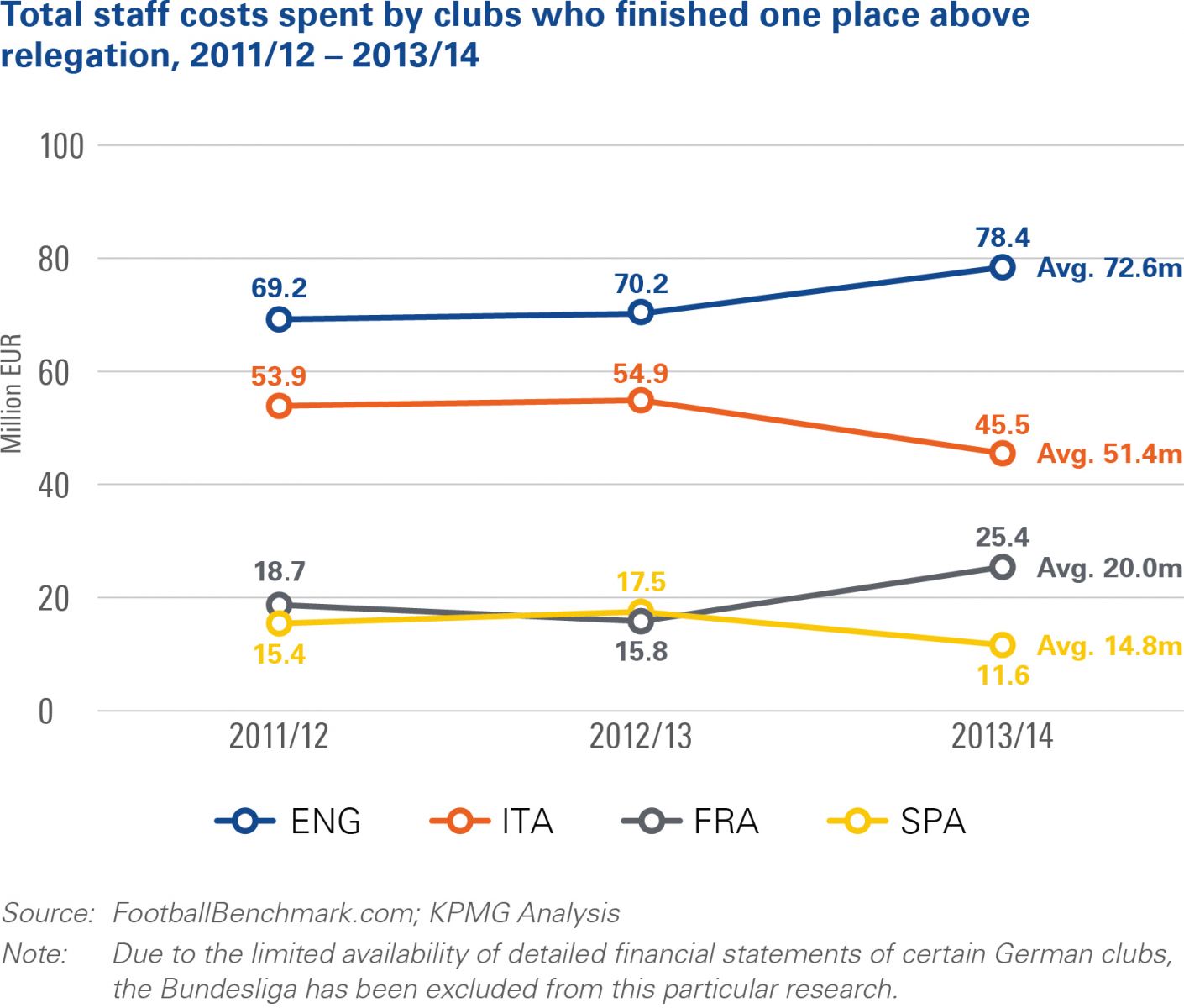With the financial rewards for remaining in the top European football divisions continuing to grow, KPMG’s Football Benchmark Team investigated the total staff costs[1] spent by football clubs who finished one place above relegation zone in four of the five major European leagues. The analysis covers football clubs which avoided relegation in the three seasons between 2011/12 and 2013/14 in the English, Italian, French and Spanish top divisions.
Based on available information, the English Premier League is, financially, the biggest football league generating aggregated turnover of around EUR 3.9 billion in the 2013/14 season. With this in mind, it is not surprising to note that the Premier League is also the most expensive league in Europe in terms of total staff costs invested by clubs to retain their league status. As shown in the chart below, the wage spending by Premier League clubs hoping to avoid relegation is consistently higher than in the three other countries analysed. Indeed, the average wage expenditure of the Premier League team one place above relegation between 2011/12 and 2013/14 seasons (EUR 72.6 million) is 40% higher than the comparable figure in Serie A and almost five times that seen in the Spanish league during the three years under review.
It is also noticeable that Premier League wage bills at clubs hoping to avoid relegation grew steadily over the three year period analysed, from the EUR 69.2 million spent by Queens Park Rangers FC in 2011/12 to the EUR 78.4 million invested by West Bromwich Albion FC in the 2013/14 season (+13%).
The gap between the Premier League and other European leagues may further increase as a new broadcasting deal worth approximately EUR 2.3 billion a year will become effective from the start of the 2016/17 season, representing an increase of approximately 70% compared to the deal currently in place. This will result in bigger budgets available to English clubs and, ultimately, could put upward pressure on staff costs at those clubs looking to avoid relegation.

Based on the available information, Serie A appears to be the second most expensive league in terms of total staff costs at football clubs just above the relegation places. The Italian clubs which maintained their league status by finishing one place above relegation over the time period 2011/12 – 2013/14 invested on average EUR 51.4 million per season.
Interestingly, in the same period, the three Italian teams which avoided relegation in those years generated, on average, revenue of EUR 52.6 million, suggesting a high level of financial instability, as their proceeds were almost entirely eroded by wages. It is also interesting to note that in the 2013/14 season, UC Sassuolo avoided relegation even after spending close to EUR 10 million less in total staff costs than the other two clubs one place above the drop in the previous two seasons in Italy.
French Ligue 1 and Spanish La Liga have much lower total staff costs deemed necessary to help avoid relegation, with wage spending being in the range of EUR 15 million - EUR 25 million per club per season. With the new Spanish broadcasting model of collective selling starting next season, we may see upward pressure in terms of costs and total wages for clubs seeking to retain a place in the Spanish top division.
The hypothesis that the higher the expenditure on wages the more likely it is that a club will avoid relegation is generally borne out from the data. This hypothesis is evident in Italy. In Serie A, the clubs who managed to finish one place above the drop-zone over the period 2011/12 – 2013/14 have always invested more than the relegated clubs. Unsurprisingly, there are exceptions to the rule. In England, for instance, Queens Park Rangers FC were relegated in 2012/13 despite investing 36% more in staff costs than Sunderland AFC, who survived.
Analysis of the French and Spanish top divisions also highlights several interesting cases; it has not always been the bigger spenders who succeed in avoiding relegation. For instance, whilst in 2011/12 Granada CF maintained their league status investing EUR 15.4 million, Villarreal CF and Sporting de Gijón were relegated even though they spent 216% and 52% more than Granada in total staff costs in that year, respectively. The same situation occurred in Ligue 1 in 2012/13 when relegated clubs AS Nancy-Lorraine and Stade Brestois 29 invested 22% and 13% more in total staff costs than AC Ajaccio, the club who managed to finish one place above relegation.
Exceptions over the years show that there may not always be a direct and exact correlation between wage expenditure and on-pitch performance. Other factors such as influential coaching and effective playing skills, team togetherness or luck with injuries, just to mention a few examples, continue to influence a club’s survival in the top division.
Further analysis of football industry data can be undertaken for you by KPMG’s Sports Practice. The subject matter experts within the group can also assist stakeholders to assess and interpret the potential impact on their organisations suggested by the results of particular pieces of research and to identify reasons why a specific trend is being observed or to assess potential solutions and future scenarios.
[1] As the notes disclosed within the Financial Statements of professional football clubs generally do not allow any further breakdown and analysis, references to “total staff costs” refer to total wage-related costs paid to football players, technical staff, medical staff, management and administrative staff.


